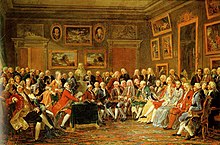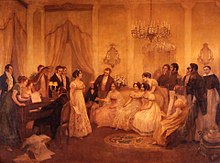沙龙 (聚会)

沙龙是由一个主人邀请其他客人参加,增加他们彼此交流的机会、愉悦自身及提升修养的聚会。沙龙最早出现于16世纪的意大利,在17至18世纪的法国中亦极为流行,直到现代仍然存在。
起源
沙龙(salon)一词最早出现于1664年的法国(来自意大利语salone,这个意大利词则来自sala,即意大利豪宅中的待客厅)。在这之前的文艺聚会通常也是以所用的房间来命名,例如内阁(cabinet)、陋室(réduit)和小巷(ruelle)等。[1] 在十七世纪末,这些聚会一般会在卧室中举行(被看做是一种私人会客厅),[2]通常情况是一位女士斜倚在床上,她的女友人们围坐在四周的椅子上。不过像法王路易十四的petit lever中,客人全部都站着。小巷(ruelle)指床和墙之间的空间,这个词一般来形容“矫揉造作的女子”的集会,这种集会出现在十七世纪上半叶受过教育的女子中。法国第一个著名沙龙是卢浮宫近处的朗布依埃府,其女主人朗布依埃侯爵夫人(1588-1665)从1607年开始一直举办沙龙直到去世。[3][4]沙龙的很多规则也是由她一手制定的。
历史
沙龙的历史十分复杂,因为这要涉及女权主义、马克思主义及各种文化、社会历史。从不同的角度可能会看到完全不同的景象,因此对于沙龙与法国历史和启蒙运动究竟有多大关系有很多见解。主流历史编纂学观点一般集中在沙龙与公共领域(诸如女性地位)的关系上。
时代划分
沙龙的历史划分要看究竟采用哪种历史编纂学观点。一般意见是从十六世纪早期到十八世纪末为一个主要时期。德娜·古德曼认为其结束在法国大革命爆发时。[5]史蒂文·凯尔的观点较为独特,他认为这段时期至少可以推迟到1848年革命之前。[6]
内容和形式
当时的文献指出沙龙的主导理念是理想主义式的礼貌、优雅和诚实,但很可能实际情况并非如此。[7][8]德娜·古德曼宣称相对作为一个“礼仪学校”(schools of civilité)来说,沙龙更是一个哲学团体,因此才推动了启蒙运动的发展。[9]礼仪的重要性只是被放在第二位。[10]

沙龙的鼎盛年代被称作“谈话时代”(age of conversation)。[11]沙龙中谈论的主题分为谈起来“礼貌”或“不礼貌”两种,沙龙的主人也被认为需要拥有缓和气氛的能力,不过所谓“礼貌”却没什么正式定义。马塞尔·普鲁斯特认为政治是一定要避开的话题。[12]但也有小部分人认为除了政府别的什么都不应该谈及。[13]
公共领域
尤尔根·哈贝马斯的《公共领域的结构转型》(1962年出版)是研究沙龙与公共领域的重要著作,该书的观点是沙龙在历史上占有不可忽视的地位。[14]他在定义“公共领域”时也把沙龙当做一个重要元素。[15][16]
在德娜·古德曼的《文学界》(The Republic of Letters)中,作者宣称“公共领域就是由沙龙、新闻界和其他社交组织构成的”。[17]该著作也进一步强调了沙龙在法国历史和启蒙运动中的重要性,这个观点自从1994年《文学界》出版以来就一直占据主流地位。[18]不过也有人认为古德曼的著作“很显然只是为了支持(哈贝马斯的)论文”,而不是去验证它。[19]
相应的反对观点来自诺博特·伊里亚思,他在《风俗史》(The History of Manners)一书中认为沙龙的重要元素——礼貌、优雅和诚实,“都是些同义词,不论广义狭义,不过是一些人为自己的行为选定的标准”。[20]琼·兰德斯(Joan Landes)也说“在某种程度上,沙龙只是制度化的宫廷的衍生物”,而不是公共领域的一部分。[21][22]其他人,例如史蒂文·凯尔宣称私人或公共领域的概念都与沙龙有重叠。[23][24]
女性和沙龙
沙龙和女性的关系也受到了历史学家的关注。[25]十九和二十世纪的很多著作一般都只谈到沙龙和丑闻及“小阴谋”(petty intrigues)的关系。[26]其他的一些则涉及到了沙龙中的女性的积极影响。[27]不过也因为沙龙中女性过多使得其研究进展困难——当时的大多数重要人物都是男性。[28]
一些历史学家试图把目光放在单个的女性身上,不过直到1970年,这些历史学家的著作大多都是关于这些沙龙主人的个人故事。[29]在二十世纪末,随着女权主义研究的进步,关于沙龙主人们的社会重要性的研究才逐渐多起来。[30]关于启蒙运动的一般性著作例如,《启蒙运动在法国》(France in the Enlightenment)倾向于认为女性的统治地位只局限于沙龙内部。[31]不过古德曼却不这么认为。[32] 她也曾说:“沙龙主人不是想挤到上流社会里,这些聪明的、受过教育的女子是通过吸收接纳文学界的价值观,并按自己的社会知识和教育需要将其用于塑造沙龙”。[33][34]
在吸引文人艺术家这一点上,沙龙不同于宫廷的是,它们并不用赞助来作为诱饵。另一个区别是其社会等级不太明显。[35]在十七十八世纪,“沙龙鼓励异性间及贵族和布尔乔亚间的社交”。[36] 因此沙龙被认为促进了社会壁垒的消失。在十八世纪,沙龙进入了启蒙运动的阵营。[37]
沙龙主人
沙龙主人一般都是些强势的女性,她们是沙龙的核心,有权挑选客人、制定规则和沙龙主题。在沙龙中她们能够得到自己想要的知识,并交换意见、给出评价,因此沙龙也被看做是这些女子对自己的继续教育。[38]十七世纪最著名的沙龙有1607年在朗布依埃府由其女主人朗布依埃侯爵夫人举办的沙龙,以及1652年史居里女勋爵举办的沙龙。
十八世纪著名的沙龙主人有:
- 乔芙兰夫人
- 唐森夫人
- 珍妮·奎纳尔特
- 朱莉·德·雷斯毕纳斯
- 德芳侯爵夫人
- 兰伯特侯爵夫人
- 缅因公爵夫人
- 德皮奈夫人
- 内克尔夫人
- 爱尔维修夫人
- 孔多塞夫人
- 罗兰夫人
- 斯威特切尼夫人
法国以外的沙龙



沙龙一度风靡欧洲,在十八到十九世纪,很多仿照巴黎式沙龙的沙龙出现在了欧洲各地,甚至包括一些新世界国家。
在十八世纪的英格兰,最著名沙龙主人是伊丽莎白·蒙塔古,“蓝袜子”(Bluestocking)一词就诞生自她的沙龙中,也是她本人成立了蓝袜社。十九世纪为避1848年革命而躲到伦敦的俄罗斯梅里男爵夫人(Baroness Méry von Bruiningk)的沙龙也很有名。1860年代,女权主义者克莱门蒂亚·泰勒在伦敦也举办过激进的沙龙,参加她沙龙的人有[39]露意莎·奥尔柯特、[40]芭芭拉·博迪肯、莉蒂亚·贝克尔和伊丽莎白·布莱克威尔[41]。
在德国,沙龙主人包括一些犹太女性例如海利薇·赫茨和拉赫尔·瓦尔哈根,西班牙有第十三代阿尔巴女公爵(18世纪),希腊则有Alexandra Mavrokordatou(17世纪)。
16世纪的意大利艺妓图利娅·达拉戈纳举办过早期沙龙,其他人还有退位后的克里斯蒂娜女王和玛丽·曼奇尼。19世纪时沙龙在意大利还再次兴盛过一段时期,并在意大利历史中占据着一定的地位。当时为了逃避政府审查,很多社会评论都是在沙龙中做出的。在这之后新闻界就取代了沙龙的位置。[42]
在伊比利亚半岛或拉丁美洲,图特利亚(tertulia)是一种类似沙龙的文艺聚会。这个词最初来自西班牙语,20世纪的图特利亚多举办在公众场合,与会者会互相分享诗歌等艺术作品。[43]阿根廷的玛利基塔·桑切斯是布宜诺斯艾利斯著名的沙龙主人。[44]她热心于革命,因此其图特利亚聚集了当时几乎所有的著名革命人物。1813年5月14日,阿根廷国歌祖国进行曲的首次歌唱就是在她的家中。[45]
在十七世纪的波兰,斯尼亚夫斯卡女公爵曾举办过沙龙,十八世纪就更加普遍了,最著名的为十八世纪末的大公斯坦尼斯瓦夫二世的周四晚餐。
在斯堪的纳维亚,沙龙由索菲亚·伊丽莎白·布伦纳在十七世纪引入瑞典。十八世纪的沙龙主人有海德薇格·夏洛塔·诺登弗吕希特和安娜·玛丽·伦格伦。十九世纪也有马拉·西尔弗斯托尔佩。在丹麦,十八世纪末的克利斯蒂安·索菲·霍尔施泰因和夏洛特·西梅尔曼对该国政治也产生了一定影响。
参见
参考文献
- ^ (法文) Dictionaire des lettres françaises: le XVIIe siècle, revised edition by Patrick Dandrey, ed. Fayard, Paris, 1996, p. 1149. ISBN 2-253-05664-2
- ^ Aronson, Nicole, Madame de Rambouillet ou la magicienne de la Chambre bleue, Fayard, Paris, 1988.
- ^ Kale,Steven.French Salons : High Society and Political Sociability from the Old Regime to the revolution of 1848. Baltimore : The Johns Hopkins University Press, 2004. p.2
- ^ Lenotre, G. Le Château de Rambouillet, six siècles d'Histoire, Calmann-Lévy, Paris, 1930. New publication, Denoël, Paris, 1984, chapter: Les précieuses, pp. 20-21
- ^ Dena Goodman, The Republic of Letters: A Cultural History of the French Enlightenment (Ithaca: Cornell University Press, 1994), p. 280.
- ^ Steven Kale, French Salons: High Society and Political Sociability from the Old Regime to the Revolution of 1848 (Baltimore: Johns Hopkins University Press, 2006) p. 9
- ^ Sisley Huddleston, Bohemian, Literary and Social Life in Paris: Salons, Cafes, Studios (London: George G. Harrap, 1928)
- ^ Steven Kale, French Salons, p. 5.
- ^ Dena Goodman, 'Enlightenment Salons: The Convergence of Female and Philosophic Ambitions' Eighteenth-Century Studies, Vol. 22, No. 3, Special Issue: The French Revolution in Culture (Spring, 1989), pp. 330
- ^ Ibid., pp. 329-331
- ^ Benedetta Craveri, The Age of Conversation (New York: New York Review Books, 2005)
- ^ Kale, French Salons, p. 5.
- ^ Ibid., p. 5.
- ^ Jürgen Habermas (trans. Thomas Burger), The Structural Transformation of the Public Sphere: An Inquiry into a Category of Bourgeois Society (Camb., Mass.: MIT Press, 1989).
- ^ Ibid., p. 30.
- ^ Joan B. Landes, Women and the Public Sphere in the Age of the French Revolution (Ithaca: Cornell University Press, 1988); Goodman, The Republic of Letters; Erica Harth, Cartesian Women: Versions and Subversions of Rational Discourse in the Old Regime (Ithaca: Cornell University Press, 1992).
- ^ Dena Goodman, The Republic of Letters: a Cultural History of the French Enlightenment (Ithaca: Cornell University Press, 1994), p. 14.
- ^ Kale, French Salons, p. 238 n. 5.
- ^ Jolanta T. Pekacz, Conservative Tradition In Pre-Revolutionary France: Parisian Salon Women (New York: Peter Lang, 1999) p. 3.
- ^ Norbert Elias (Trans. Edmund Jephcott), The Civilising Process: The History of Manners, Vol. 1 (Oxford: Basil Blackwell, 1978), pp. 39-40.
- ^ Landes, Women and the Public Sphere in the Age of the French Revolution, pp. 23-5.
- ^ Landes, Women and the Public Sphere in the Age of the French Revolution, p. 23
- ^ Kale, French Salons, p. 12.
- ^ Antoine Lilti, ‘Sociabilité et mondanité: Les hommes de lettres dans les salons parisiens au XVIIIe siècle’ French Historical Studies, Vol. 28, No. 3 (Summer 2005), p. 417.
- ^ Jolanta T. Pekacz, Conservative Tradition In Pre-Revolutionary France: Parisian Salon Women, p. 1.
- ^ S. G. Tallentyre, Women of the Salons (New York: G. P. Putnam’s Sons, 1926) and Julia Kavanagh, Women in France during the Enlightenment Century, 2 Vols (New York: G. P. Putnam’s Sons, 1893).
- ^ Edmond et Jules Goncourt, La femme au dix-huitème siècle (Paris: Firmin Didot, 1862) and Paul Deschanel, Figures des femmes (Paris: Calmann-Lévy, 1900).
- ^ Pekacz, Conservative Tradition In Pre-Revolutionary France, p. 2.
- ^ Anny Latour (Trans. A. A. Dent), Uncrowned Queens: Reines Sans Couronne (London: J. M. Dent, 1970)
- ^ Carolyn C. Lougee, Women, Salons and Social Stratification in Seventeenth Century France, pp. 3-7.
- ^ Daniel Roche (Trans Arthur Goldhammr), France in the Enlightenment, (Cambridge, Mass.: HUP, 1998), pp. 443-8.
- ^ Goodman, The Republic of Letters, pp. 1-11.
- ^ Ibid., p. 76.
- ^ Pekacz, Conservative Tradition In Pre-Revolutionary France, p. 6; Lilti, ‘Sociabilité et mondanité, p. 2.
- ^ Goodman,Dena.Enlightenment salons: The Convergence of Female and Philosophic Ambitions. Eighteenth-Century Studies, Vol. 22. 3, Special issue : The French Revolution in Culture. ( Spring, 1989),p 338
- ^ Kale,Steven.French Salons : High Society and Political Sociability from the Old Regime to the revolution of 1848. Baltimore : The Johns Hopkins University Press,2004. p.2
- ^ Goodman,Dena.Enlightenment salons: The Convergence of Female and Philosophic Ambitions. Eighteenth-Century Studies, Vol. 22. 3, Special issue : The French Revolution in Culture. ( Spring, 1989),p.331
- ^ Bodek, Evelyn Gordon.Salonnières and the Bluestockings : Educated Obsolescence and Germinating feminism, Feminist Studies, Vol. 3 No. 3/4 ( spring-summer, 1976), p. 186
- ^ Moncure Daniel Conway. Autobiography Memories and Experiences of Moncure Daniel Conway. Volume 2. Elibron.com. June 2001: 14– [1 December 2012]. ISBN 978-1-4021-6692-1. (原始内容存档于2014-06-27).
- ^ TayODNB.
- ^ MunODNB.
- ^ Romani, Gabriela. A room with a view: interpreting the Ottocento through the literary salon.. [16 April 2012]. (原始内容存档于2013-05-24).
- ^ El Madrid de 1900, espacios populares de Cultura y Ocio (页面存档备份,存于互联网档案馆) [Madrid in 1900, popular spaces for culture and leisure]; Tertulia Andaluza (页面存档备份,存于互联网档案馆) ("Tertulia Andaluza")
- ^ Soledad Vallejos. Recuperando a Mariquita. Perfil. July 16, 2004 [February 10, 2013]. (原始内容存档于2014-05-14).
- ^ Galasso, Norberto. Seamos libres y lo demás no importa nada [Let us be free and nothing else matters]. Buenos Aires: Colihue. 2000: 102. ISBN 978-950-581-779-5 (西班牙语).
参考书目
- Craveri, Benedetta, The Age of Conversation (New York: New York Review Books, 2005)
- Davetian, Benet, Civility: A Cultural History (University of Toronto Press, 2009)
- Elias, Norbert, (Trans. Edmund Jephcott), The Civilising Process: The History of Manners, Vol. 1 (Oxford: Basil Blackwell, 1978)
- Goodman, Dena, The Republic of Letters: A Cultural History of the French Enlightenment (Ithaca: Cornell University Press, 1994)
- Goodman,Dena, Enlightenment Salons: The Convergence of Female and Philosophic Ambitions, Eighteenth-Century Studies, Vol. 22, No. 3, Special Issue: The French Revolution in Culture (Spring, 1989), pp. 329–350
- Kale, Steven, French Salons: High Society and Political Sociability from the Old Regime to the Revolution of 1848 (Baltimore: Johns Hopkins University Press, 2006)
- Habermas, Jürgen, (trans. Thomas Burger), The Structural Transformation of the Public Sphere: An Inquiry into a Category of Bourgeois Society (Camb., Mass.: MIT Press, 1989)
- Harth, Erica, Cartesian Women: Versions and Subversions of Rational Discourse in the Old Regime (Ithaca: Cornell University Press, 1992).
- Huddleston, Sisley, Bohemian, Literary and Social Life in Paris: Salons, Cafes, Studios (London: George G. Harrap, 1928)
- Kavanagh, Julia, Women in France during the Enlightenment Century, 2 Vols (New York: G. P. Putnam’s Sons, 1893)
- Landes, Joan B., Women and the Public Sphere in the Age of the French Revolution (Ithaca: Cornell University Press, 1988);
- Latour, Anny (Trans. A. A. Dent), Uncrowned Queens: Reines Sans Couronne (London: J. M. Dent, 1970)
- Lougee, Carolyn C., Le Paradis des Femmes: Women, Salons and Social Stratification in Seventeenth Century France (Princeton: Princeton University Press, 1976)
- Lilti, Antoine, Sociabilité et mondanité: Les hommes de lettres dans les salons parisiens au XVIIIe siècle, French Historical Studies, Vol. 28, No. 3 (Summer 2005), p. 415-445
- Pekacz, Jolanta T., Conservative Tradition In Pre-Revolutionary France: Parisian Salon Women (New York: Peter Lang, 1999)
- Roche, Daniel, (Trans Arthur Goldhammr), France in the Enlightenment, (Cambridge, Mass.: HUP, 1998)
- Tallentyre, S. G., Women of the Salons (New York: G. P. Putnam’s Sons, 1926)
- Von der Heyden-Rynsch, Verena, Europaeische Salons. Hoehepunkte einer versunken weiblichen Kultur (Düsseldorf: Artemis & Winkler, 1997)
扩展阅读
- Beasley, Faith E. Salons, History, and the Creation of Seventeenth-Century France. Hampshire: Ashgate Publishing Company,2006.
- Bilski, Emily et al. Jewish Women and Their Salons: The Power of Conversation, Jewish Museum New York, 2005.
- Craveri, Benedetta. The Age of Conversation. Trans.Teresa Waugh. New York: New York Review Books,2005.
- Benet Davetian "The History and Meaning of Salons" (页面存档备份,存于互联网档案馆)
- James Ross, ‘Music in the French Salon’; in Caroline Potter and Richard Langham Smith (eds.), French Music Since Berlioz (Ashgate Press, 2006), pp. 91–115. ISBN 0-7546-0282-6.
- Mainardi, Patricia. The End of the Salon: Art and the State of the Early Republic. New York: Cambridge University Press, 1993.
- Hertz, Deborah. "Jewish High Society in Old Regime Berlin." New Haven and London: Yale University Press, 1988.
外部链接
- 私人沙龙:
- Mlle de Scudéry
- Les Contes de Fées: The Literary Fairy Tales of France: 17th-century Paris salons of Mme d'Aulnoy, the comtesse de Murat and others by Terri Windling.
- Julie de Lespinasse, Mme Geoffrin in memoirs. (页面存档备份,存于互联网档案馆)
- The Women of the French Salons (页面存档备份,存于互联网档案馆) by Amelia Ruth Gere Mason
- Americans in Paris: Natalie Barney, Gertrude Stein, and Sylvia Beach. (页面存档备份,存于互联网档案馆) Three 20th century salons.
- Charlottetown Conversation Salon (页面存档备份,存于互联网档案馆)
- Benet Davetian's Article on the History and Meaning of Salons (页面存档备份,存于互联网档案馆)
- Biographies of French salonists (页面存档备份,存于互联网档案馆) from Madame de Rambouillet to Madame Recamier and descriptions of salon culture from the 17th to the 19th century.
- The Genius Salon An active online salon.
- 艺术展览:
- Paris Salon of 1769: photos illustrate some of the paintings shown that year.
- Comic art: The Paris Salon in Caricature (页面存档备份,存于互联网档案馆): Getty Museum exhibition, 2003.
- Jewish Women and Their Salons (页面存档备份,存于互联网档案馆)
Text is available under the CC BY-SA 4.0 license; additional terms may apply.
Images, videos and audio are available under their respective licenses.
